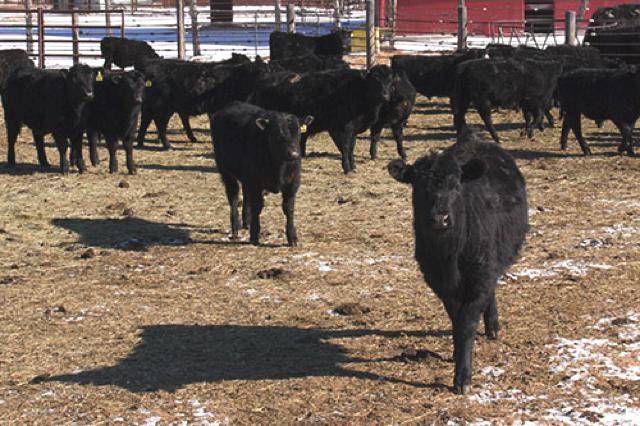Written by Laura Stewart, University of Regina School of Journalism
Beef production is often criticized for its methane emissions, but carbon can be stored in the pastures and hay fields that feed cattle like these recently weaned calves on the GBT Angus ranch near Wawota. Photo by Laura Stewart.
The province of Saskatchewan recently passed up a chance to secure $62 million in federal funding for reducing greenhouse gas emissions, but Saskatchewan farmers may still find ways to get paid for doing their part.
The province’s climate strategy, announced in December 2017, could bring that goal closer. By setting a price for large industrial operations to buy offsets for the carbon they release, the plan will boost the market value for carbon stored in soil.
Cedric MacLeod, the executive director of the Canadian Forage and Grasslands Association, said in an interview, “It comes down to whether or not it’s a voluntary or a legislated, regulated market.”
MacLeod gave the example of Alberta, where the government set prices to start at $15 per tonne of carbon dioxide and go up, even though they had been getting only $2 to $5 per tonne on a voluntary basis.
But before agricultural producers can get that money, they need a way to prove they have stored carbon in a measurable, meaningful way.
Grains and other agricultural products contain carbon, but most of it cycles quickly back to the atmosphere when humans eat the final food product for energy and breathe out carbon dioxide.
Instead researchers look for carbon “sinks” – places where carbon is building up over time. One promising place to look is agricultural soil.
Historically, Prairie soils lost carbon when tillage (cultivation) exposed roots and other organic matter in the soil to decay. But if farmers can reduce tillage and tip the balance so plant growth is putting more carbon into the soil than decay is taking out, then the soil becomes a sink.
The Saskatchewan Soil Conservation Association has been collaborating on a study to show how soil carbon has changed since farmers started using zero-till methods in the 1990s. John Bennett, a farmer and advisory committee member with the association, said early modeling assumed soil carbon would increase for a while but soon reach a new steady state, or saturation, where no new storage was occurring. But up to the latest sampling in 2011, at a network of sites across the province, soil carbon was still increasing. Bennett said, “At the moment, the best data we have, which is the Prairie Soil Carbon Balance Project, is suggesting that saturation is a long way away.”
Bennett sees potential for soil to eventually store even more carbon than it had before cultivation, as farmers continue to find new ways to increase plant productivity.
For example, when the soil carbon study started, farmers were removing tillage. Later they added more crops in rotation, and changed equipment to place fertilizer better for efficient plant growth. New revenue from carbon offsets might open up possibilities for further improvements.
Although the study focused on the effects of zero-till, the association wants to expand it to look at other ways of storing carbon. “We’re advocating we need a Prairie Soil Carbon Balance Project II, that has way more facets, and it has to address forages, managed rangelands, a whole plethora of things that have to be brought into it,” Bennett said.
Forages (plants used for grazing or hay for livestock) are the focus of a new Canada-wide project. The Canadian Forages and Grassland Association recently received federal funding under the Agricultural Greenhouse Gases Program to find out how farmers can best store carbon in pastures and hay fields.
But there’s a lot of variation across different regions, farm operations, and research findings. The project will start by sorting out how to calculate carbon storage.
“What we’re working on right now is a quantification protocol, which is the very first step,” MacLeod said.
At a November technical workshop, researchers agreed they can already show a clear carbon-storing benefit of keeping grassland intact and not converting it to cropland.
The next step is to figure out what farmers and ranchers can do differently to coax their existing pastures and hay fields to store even more carbon.
“The third [step] is actually to fire some pilot [sites] out on the landscape. That allows us to, A) test the protocol, and B) showcase these high-performance best-management practices,” MacLeod said. Soon, MacLeod hopes the project can at least help “get a few dollars in producers’ jeans for maintaining the carbon we know they have.”
Of course, all that will depend on the price of carbon.
Meanwhile, even if they’re not directly paid for it, farmers and ranchers can still see returns for building up their soil. MacLeod said a pasture with more root mass has more soil carbon, but it also produces more forage and more beef. Bennett cited the past growing season as evidence of improved climate resilience under contemporary cropping methods. “If we went south of the Trans-Canada Highway last year, we had the driest year in, maybe recorded history, or very close to it. We actually didn’t have any soil erosion to speak of, and we grew a crop,” he said.




